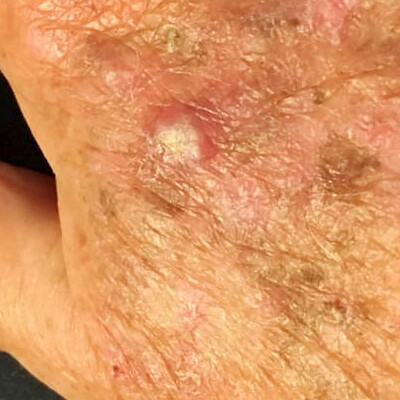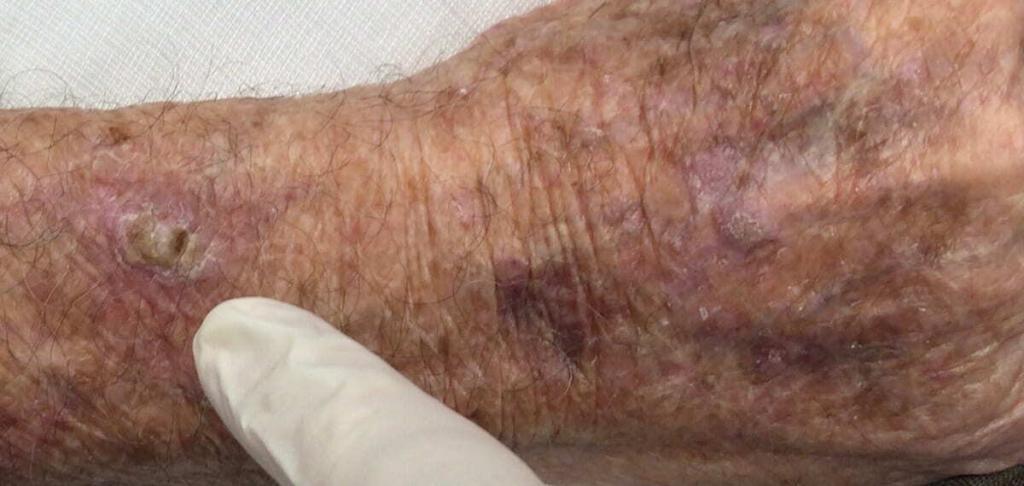Squamous Cell Skin Cancer
Dr. Beal is an expert in Mohs Surgery, which has greater than a 99% cure rate for most skin cancers.
What is Squamous Cell Carcinoma?
Squamous cell carcinoma is the second most common type of skin cancer. Over 1 million new cases of squamous cell carcinoma are diagnosed annually.
Squamous cell carcinoma is an abnormal growth of the squamous cell of your skin. Squamous cell carcinoma can be a dangerous type of skin cancer. It can spread (metastasize) to your lymph nodes or to distant sites, but thankfully this is rare, occurring in 2% to 5% of these cancers. If treated early most squamous cell carcinomas have a cure rate greater than 98%. If these skin cancers are not treated early or with proper treatment they can spread (metastasize).
In the Southern half of the United States, there are more skin cancer deaths from squamous cell carcinoma than melanoma. This is due to the large amount of sun exposure in the Southern United States. Patients who have organ transplants or Chronic Lymphocytic Leukemia are more likely to develop squamous cell skin cancers and should be seen by a Board-Certified Dermatologist regularly.
What does squamous cell carcinoma look like?
Squamous cell carcinomas most often affect areas with lot of sun exposure such as the face, scalp, neck, ears, backs of hands, forearms, and shins. Squamous cell carcinomas can occur in many other areas of the skin. Squamous cell carcinoma often looks like a rough scaly spot, scab or sore that just will not heal. They tend to bleed easier than normal skin.
Scabs and scratches typically heal within 4 weeks. Skin cancer does not heal because the cells are abnormal. If you have a non-healing scab or sore, and it has been more than 4 weeks you should call your dermatologist to have this spot examined.
It is very important to note that while these characteristics are some of the most common signs of squamous cell carcinoma, there is no substitute for your skin concern being examined in person by a Board-Certified Dermatologist. This is the gold standard for having any of your skin concerns addressed. Your Board-Certified Dermatologist will perform a comprehensive examination and is the expert when it comes to diagnosis and treating skin cancers.
What causes squamous cell carcinoma?
- Cumulative sun exposure over your entire life.
- Tanning beds or sunlamps
How is squamous cell carcinoma diagnosed?
Squamous cell carcinoma is diagnosed with a skin biopsy. A skin biopsy is a minor procedure where your dermatologist will numb the area, and then take a sample of your lesion. This sample is examined microscopically for skin cancer cells. If skin cancer cells are seen, further treatment is required.
What is the best treatment for squamous cell carcinoma?
The best treatment for squamous cell carcinoma depends on several factors: the type of squamous cell carcinoma; the location of the skin cancer; your health and medical conditions. Your dermatologist can assess your skin cancer and come up with an individualized treatment to meet your goals and specific needs.
When appropriate, Mohs surgery is the treatment that offers the highest cure rate amongst all treatments. 99% of all squamous cell carcinomas can be cured with Mohs Surgery. Mohs surgery is a technique that preserves your normal skin, only removing the skin cancer, and thereby minimizing scaring and maximizing your cosmetic outcome. Mohs surgery is the most advanced treatment for squamous cell carcinoma.
When is it appropriate to treat a squamous cell carcinoma with Mohs Surgery?
- If it is located on your face, neck, scalp, hands, feet, or shins (any size or type)
- If it is an aggressive subtype of squamous cell carcinoma
- If it is greater than 2 cm (0.78 inches) located anywhere on your body
Did you know:
- You can use your smartphone to take photos of your skin to document your moles, both how they look and their location. Then, if in the future you are concerned a spot changed, you can refer back to those high-quality photos. Click here for link to how to take high quality photos.
Brandon T. Beal, MD


Brandon T. Beal, MD is an expert in the diagnosis and treatment of skin cancer. He is a Board-Certified Dermatologist, and Fellowship trained Mohs Micrographic Surgeon, dermatologic oncologist (cancer doctor of the skin), and facial reconstructive surgeon.
Dr. Beal completed his dermatology residency at the Cleveland Clinic Dermatology & Plastic Surgery Institute and his fellowship in Mohs Micrographic Surgery, dermatologic oncology, and facial reconstructive surgery at Zitelli & Brodland, PC. Dr. Beal trained at the Cleveland Clinic’s Melanoma program, a multidisciplinary team of dermatopathologists, pathologists, dermatologists, and surgical, medical, and radiation oncologists.
Dr. Beal provides each patient comprehensive counseling on the diagnosis and treatment of skin cancer, a thorough skin examination from head to toe, and an individualized treatment plan based on evidenced-based medicine. Dr. Beal is an expert in Micrographic Surgery (Mohs Surgery) which is the treatment that provides the highest cure rates, greater than 99% for most skin cancers. He follows the National Comprehensive Cancer Network Guidelines as well as the American Joint Committee on Cancer staging guidelines.
Mohs Surgery & Mohs Procedure St. Louis
Mohs Micrographic Surgery is the treatment that offers the highest surgical cure rate amongst all treatments for skin cancer. Mohs surgery is a technique that preserves your normal skin, focusing on just removing the skin cancer, and thereby minimizing scaring and maximizing your cosmetic outcome. Mohs Micrographic surgery is the most advanced treatment for skin cancer.
Mohs Micrographic Surgery is the only surgical technique that examines 100% of the margin (edges) of the specimen (skin cancer) that is removed. Meaning, 100% of the side and bottom edges of the specimen are examined microscopically to ensure there are no skin cancer cells at the edges. This provides patients with the highest cure rates, smallest scars, and best cosmetic outcomes for their skin cancer.



